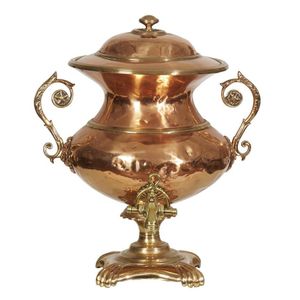George III Silver Sugar Basin with Floral Designs
You must be a subscriber, and be logged in to view price and dealer details.
Subscribe Now to view actual auction price for this item
When you subscribe, you have the option of setting the currency in which to display prices to $Au, $US, $NZ or Stg.
- Hallmarks - A mark stamped on articles of precious metals in Britain, since the 14th century, certifying their purity. It derives its name from the Guild Hall of the Goldsmiths' Company, who recieved its Charter in 1327 giving it the power to assay (test the purity) and mark articles of gold and silver.
The hallmark will consist of several marks, including the:
- silver standard mark, indicating the purity of the metal. Sterling silver is .925 pure silver.
- the city mark indicating the city in which it was assayed eg London, Birmingham, York etc.
- the date mark, usually a letter of the alphabet in a particular font and case,
- a duty mark, indicating whether duty had been paid to the crown, and only in use from 1784 to 1890
The piece may include an additional mark, the maker's mark, although not forming part of the hallmark, will be located in the vicinity of the hallmarks.
Sometimes silver plated items will bear faux hallmarks, often confusing those not familiar with silver markings. - Sterling Silver - Sterling silver is a mixture of 92.5% pure silver and 7.5% of another metal, usually copper. Fine silver is 99.9% pure silver, and is relatively soft and the addition of the very small amount of copper gives the metal enough strength and hardness to be worked into jewellery, decorative and household objects.
- Husk Motif - The husk motif is a decorative element that has been used in furniture, silver, glass and ceramics decoration for centuries. The motif is typically based on the shape of the husk, or outer covering, of a nut or seed. It is often depicted as a series of overlapping, scalloped shells that create a textured, ornamental pattern.
In furniture, the husk motif is commonly used in the design of chair and table legs, as well as in the decoration of cabinet doors and drawer fronts. The motif is carved into the wood or other material, creating a three-dimensional effect that adds depth and visual interest to the piece.
In ceramics, the husk motif is used in a variety of ways, from the decoration of bowls and plates to the design of decorative tiles and other objects. The motif is often painted or carved into the surface of the clay, creating a relief pattern that adds texture and dimensionality to the piece.
The husk motif has been used in many different historical and cultural contexts, from ancient Greece and Rome to 18th-century France and England. It has been adapted and modified over time, with variations including the acanthus leaf and the palmette motif. - George Iii - George III (1738 - 1820) was King of Great Britain and Ireland from 1760 to 1820.
This item has been included into following indexes:
Visually similar items

A part Chinese export silver tea set, silver jug and basin, circular form, embossed floral pattern, pedestal feet, c.1860; Cutshing, Canton. Silver-plate teapot, of same design, circular form, embossed floral pattern, pedestal feet; T Wilkinson & Sons, Bir

A brass and copper samovar height 42 cm

George III sterling silver teapot circular shape embossed with floral and cartouche, the hinged lid with floral finial, on shell and scroll feet, London, 1794

Thomas Cox Savory, London 1827 sterling silver mustard pot raised decoration of flowers and leaves, clear glass liner. Weight 142 grams
